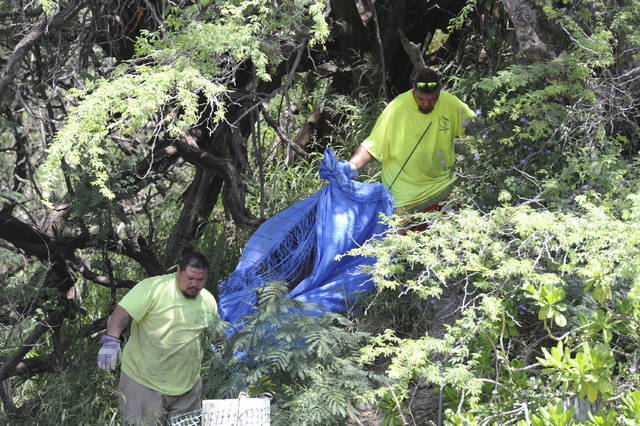State clears homeless encampments from Diamond Head

BRUCE ASATO / BASATO@STARADVERTISER.COM
Workers with T&M Environmental dragged a tarp filled with debris from Diamond Head’s makai slopes on Wednesday in a state sweep of homeless camps there. There was so much debris, the contractor had cleared just three makeshift houses by midday.
Following six months of warnings, state law enforcement officers early Wednesday morning swept through 40 or so homeless encampments on the slopes of Diamond Head, where seven people had remained atop the Hawaii landmark.
All seven were cited for petty misdemeanor violations of being in a closed area. They were ordered to appear in court May 3, and face maximum fines of $1,000.
Diamond Head has long been home to a revolving group of chronically homeless people who carved ramshackle living quarters out of thick kiawe. They typically have little interest in interacting with others, including those living around them.
How to keep them from returning to Diamond Head remains unclear.
“That’s still under discussion,” said Dan Dennison, spokesman for the state Department of Land and Natural Resources, which led Wednesday’s sweep. “Everyone feels we’ve got to do something so we don’t keep coming back every six months. You almost have to have someone out here monitoring 24 hours a day.”
Neighbor Scott Ballentyne, 62, has been complaining about Diamond Head’s homeless population for years.
Don't miss out on what's happening!
Stay in touch with breaking news, as it happens, conveniently in your email inbox. It's FREE!
He has little hope that Wednesday’s sweep will keep homeless people from returning.
More likely, Ballentyne said, the homeless who left will probably become some other neighborhood’s problem.
“It’s like playing whack-a-mole,” Ballentyne said. “You hit ’em and they come up somewhere else. Now they’ll have to go further toward Kahala to find somewhere else to live.”
But even with a homeless population that prefers to live off the grid, efforts are underway to connect those from Diamond Head with services that might help, including permanent housing, said Scott Morishige, the state’s homeless coordinator.
“The goal is not just to move people around from one place to another,” Morishige said. “It really is to connect people to services that are appropriate to their specific situation, just like we have in other areas.”
Two military veterans who were living on Diamond Head and had each been homeless for a decade were placed into permanent housing following months of outreach by social workers, Morishige said.
Social workers from Kalihi-Palama Health Center, the Institute for Human Services and the Community Health Outreach Work to Prevent AIDS Project will continue to try to connect others who were identified on Diamond Head with homeless services, Morishige said.
There is no running water or sanitation on the flanks of Diamond Head. Many of the people who left ahead of Wednesday’s sweep abandoned encampments that often included piles of human feces and buckets filled with human waste.
“We know for a fact that a lot just defecated on the ground or in a bucket,” Dennison said. “There were a lot of water bottles. A lot. They were probably hauling their water up there.”
DLNR staff have been warning the homeless on Diamond Head that a sweep was likely in mid-March.
Then on Wednesday, 30 minutes before sunrise, a dozen of DLNR’s Division of Conservation and Resource Enforcement officers moved in.
The occupants included one family with a child, but the rest were single adults or couples, Morishige said.
“This is a population largely living in isolation,” Morishige said.“These areas are very geographically spread out and separated not only by distance, but also by brush and rocky terrain. They wanted to be separate and apart, and have a sense of privacy.”
Dennison described the area as “tough, rugged country that’s pretty overgrown.”
One person with two dogs lived in a war-era bunker “that looked like a small, one-bedroom apartment with framed pictures and statues and statuettes,” Dennison said. “It was pretty elaborate.”
Others created structurally sound shelters out of kiawe branches.
“One guy took dead and live kiawe and turned it into a canopy,” Dennison said. “It was just as solid as can be. It was impressive. Others had built ceilings out of kiawe. … There were pretty fancy camp stoves. Otherwise, there were lots of tents and tarps — and a lot of rubbish all around.”
There was so much discarded trash and debris that cleanup crews from a private Oahu contractor, T&M Environmental, were able to clear only three of the dozens of encampments by midday, Dennison said.
The state contracted to pay T&M Environmental $12,000 for the work, Dennison said.
“Diamond Head is Hawaii’s most iconic natural landmark,” he said. “It’s not here for people to live permanently. We don’t want our state parks viewed as a place where people can set up permanent housing. … On the flip side, we have a lot of empathy for the people who find themselves in this situation, for whatever reason.”
In prepared statements, other DLNR officials also tried to balance compassion with the need for enforcement.
“We empathize with anyone in Hawaii who does not have a home, and thank Gov. Ige’s homelessness team for the work they are doing to find shelter for people who do not have it,” state parks administrator Curt Cottrell said in a statement. “State lands, though, are owned by all of Hawaii’s residents and cannot be used as a place for long-term camps.”




